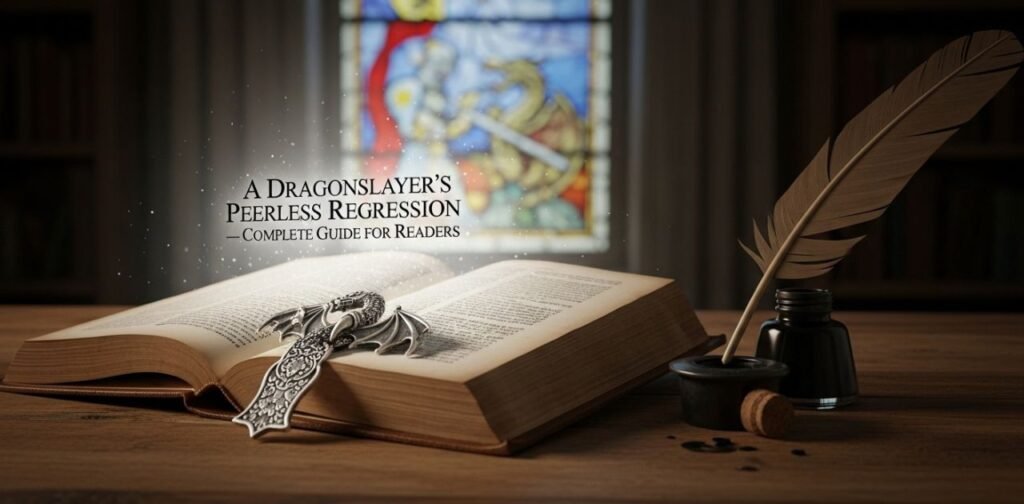In the vast landscape of fantasy fiction, regression-themed stories have carved out a massive fanbase. These tales revolve around heroes who turn back time, reliving their lives with the knowledge of their past failures. Among them, A Dragonslayer’s Peerless Regression has emerged as one of the most intriguing titles. Blending themes of rebirth, redemption, and unyielding determination, it captures the timeless struggle between mortals and dragons while exploring the philosophical weight of second chances.
This ultimate guide explores the story’s premise, themes, and unique appeal, while also helping new readers understand what sets this tale apart from other regression or reincarnation narratives.
The Premise of A Dragonslayer’s Peerless Regression
At its heart, A Dragonslayer’s Peerless Regression tells the story of a once-defeated warrior who gains the chance to redo his life. After failing to slay an all-powerful dragon and losing everything he held dear, the protagonist is granted regression — a return to the past armed with the painful knowledge of what went wrong. This second chance is both a blessing and a curse.
Unlike typical fantasy narratives where the hero slowly builds power from scratch, regression gives the main character foresight. He remembers battles, betrayals, and mistakes that doomed him before. This creates a unique tension: every decision carries the weight of déjà vu, yet every change could alter the future in unexpected ways.
Dragons serve as more than just monsters in this story. They embody insurmountable challenges, primal fear, and the limits of human willpower. By pairing the concept of regression with dragonslaying, the narrative emphasizes resilience against overwhelming odds. The title itself — “peerless” — suggests that the dragonslayer’s new journey will surpass all past attempts, aiming for unmatched mastery.
What makes the premise stand out is its blend of high-stakes combat, emotional character development, and philosophical exploration of time. The protagonist is not simply fighting dragons; he is battling regret, destiny, and the very weight of history.
Themes and Symbolism in the Story
One of the biggest reasons readers are drawn to A Dragonslayer’s Peerless Regression is its layered symbolism and recurring themes.
1. Redemption and Regret
Regression stories often explore the human desire to undo mistakes. The dragonslayer embodies this wish: the need to redeem failures, protect loved ones, and prove one’s worth. Each step forward is a step away from regret — but also a confrontation with the consequences of altering fate.
2. Fate vs. Free Will
Does knowing the future guarantee control? Or does trying to change events create new, unforeseen consequences? The story examines whether destiny is fixed or malleable, adding a philosophical dimension to the hero’s choices.
3. The Dragon as Archetype
Dragons have long represented ultimate trials in mythology — greed, destruction, chaos, or divine punishment. In this tale, they also represent inner demons: fear, despair, and self-doubt. Slaying dragons becomes both a physical and psychological victory.
4. Growth Beyond Power
While the protagonist gains strategic foresight through regression, the true transformation comes from wisdom, empathy, and resilience. Instead of simply becoming stronger, he evolves as a leader, mentor, and protector.
Symbolism is deeply woven throughout the narrative. Regression represents humanity’s yearning for “do-overs,” while dragons represent the immovable forces that define existence. Together, they create a tale that resonates with readers on both emotional and intellectual levels.
Why A Dragonslayer’s Peerless Regression Stands Out in the Genre
Regression and reincarnation stories are not new, especially in light novels, manhwa, and web novels. Yet, A Dragonslayer’s Peerless Regression distinguishes itself through several unique qualities.
1. Strong Characterization
Instead of relying solely on overpowered abilities, the story emphasizes emotional depth. The protagonist is not invincible; he struggles with trauma, guilt, and the loneliness of being the only one who remembers the past timeline.
2. The Weight of Consequence
In many regression tales, knowledge of the future makes the hero unstoppable. Here, foresight is both a tool and a burden. Trying to “fix” the past creates ripple effects, forcing the hero to constantly adapt.
3. Rich World-Building
The setting isn’t just a backdrop for battles. Kingdoms, guilds, and even dragon societies are fleshed out, giving readers a living, breathing world that responds to the hero’s changes.
4. Balance of Action and Reflection
The narrative alternates between thrilling dragon-slaying battles and quieter moments of self-reflection. This balance prevents burnout and deepens immersion.
5. Reader Connection
Ultimately, many readers relate to the desire for a second chance. Whether it’s fixing past mistakes or pursuing dreams left behind, the story resonates universally. The dragons may be fictional, but the emotions are real.
This combination of emotional depth, narrative complexity, and exhilarating combat makes A Dragonslayer’s Peerless Regression a standout entry in regression-based fantasy.
FAQs about A Dragonslayer’s Peerless Regression
1. What is the main plot of A Dragonslayer’s Peerless Regression?
It follows a warrior who fails to defeat a dragon but gains the ability to regress in time, giving him a second chance to rewrite his destiny and protect what he once lost.
2. How is it different from other regression stories?
Unlike many where the protagonist becomes overwhelmingly powerful, this tale focuses equally on emotional growth, consequences of changing the past, and the symbolism of dragons.
3. Is it only about fighting dragons?
No. While dragon battles are central, the story also explores politics, relationships, philosophy, and the emotional cost of regression.
4. Who would enjoy this story?
Fans of fantasy, character-driven narratives, and readers who enjoy themes of redemption, time manipulation, and epic battles will find it especially compelling.
5. Are the dragons just villains?
Not always. Some dragons embody pure destruction, while others have complex motives, making them more than one-dimensional enemies.
6. Is there romance in the story?
Yes, but it develops naturally alongside the main plot. The focus remains on growth, redemption, and dragonslaying, with romance adding emotional depth.
7. Does the protagonist remain overpowered after regression?
While regression gives him foresight, challenges escalate. He must constantly adapt, proving that knowledge alone doesn’t guarantee victory.
8. Why do readers connect so strongly with regression themes?
Because everyone has regrets. The fantasy of turning back time and making better choices resonates deeply with human experience.
Conclusion — The Timeless Appeal of Regression Fantasy
A Dragonslayer’s Peerless Regression is more than just another entry in the regression genre. It’s a meditation on failure, resilience, and the eternal struggle against forces bigger than ourselves. By intertwining dragons — the quintessential symbols of ultimate trials — with the concept of time regression, the story creates a powerful narrative about growth, redemption, and destiny.
Its brilliance lies not in making the protagonist flawless, but in showing how second chances are fraught with new challenges. Readers witness a hero who must learn not only to fight harder but also to think wiser, love deeper, and face the psychological burden of memory.
As regression-based stories continue to grow in popularity, A Dragonslayer’s Peerless Regression stands as a model of how to do it right: blending thrilling action with profound emotional resonance. It reminds us that while we can’t truly turn back time, we can learn, grow, and face our own “dragons” with courage.
Looking to the future, regression tales will likely evolve further, mixing with science fiction, mythology, and new forms of storytelling. Yet, the timeless allure of “what if I could do it again?” will always captivate audiences. And among them, the saga of the peerless dragonslayer will continue to inspire readers who dream not just of second chances, but of making them count.



